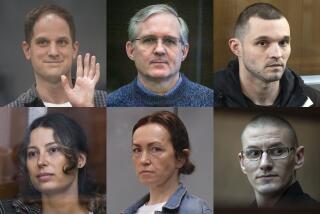A Man of Ingenious Escape Ideas
- Share via
Iouri Mikhel’s first plot to escape federal custody unraveled when an inmate housed beneath him in the downtown Metropolitan Detention Center noticed bits of gravel in an overflowing toilet.
The Russian emigre -- whose trial for allegedly murdering five Los Angeles residents and dumping their bodies in a remote reservoir began last month -- soon found himself in solitary confinement, under security measures designed for terrorists.
But the feds would not break his will. As dead-set as they were to bring him to trial, Mikhel was equally determined to get out -- and prosecutors feared he might have the brains and money to pull it off.
In this battle of wills, described in recent court filings, Mikhel began noting details of his new confines at the Central Detention Center in San Bernardino that only the most meticulous mind could formulate into a feasible road map for escape.
The court records say he plotted his various ways of escaping for nearly three years, creating detailed plans that surprised even veteran jailers when they discovered them at the Los Angeles center in March 2003 and in San Bernardino in January 2004.
Mikhel allegedly continued to “test institutional security” despite the setbacks. To scope out jail hospital security, he sliced a vein in his leg and overdosed on medication that he had hoarded in his cell, according to an affidavit from San Bernardino County Sheriff’s Lt. Jack Trotter.
The revelations raise questions about security for federal detainees in the Southland.
In San Bernardino, Mikhel was put under what U.S. officials describe as their tightest restrictions. But he managed to correctly note enough basic security weaknesses that deputies thought the escape plan could have worked, court documents say.
The motion detector on top of the recreation yard fences is not set to a sensitive mode because of the high winds. The parking lot is empty in the early morning except when the garbage truck comes between 6 a.m. and 6:15 a.m. Friday is an overtime shift for the guards, and there is usually only one in the towers. The arch of the padlock at the gate is 3/8 inch of strengthened steel. The outside of the center is not patrolled.
Those observations culminated in a virtual primer for would-be escapees.
The step-by-step plan was uncovered when a guard found a letter wrapped in a Russian newspaper hidden in a trash can. In tiny, fastidious penmanship, Mikhel charted out the escape and offered $1 million to “Jason” to help him carry it out. Mikhel noted that the job could be contracted out to someone else.
“I have no vanity complex,” the letter says. “But in this particular case it would be very nice to outsmart the feds this time!”
Mikhel’s attorneys call the letter “Iouri’s musings,” not an escape attempt. They concede that he is trying to avoid the trial -- by trying to kill himself, most recently attempting to hang himself last month -- but they scoff at the allegation that slitting an artery or the overdose was part of an escape plan.
“He was unconscious for two days, so I don’t know how good his [reconnaissance] could have been,” said his attorney, Dale Rubin.
But officials at the detention center -- operated by the San Bernardino County Sheriff’s Department and contracted to hold federal inmates waiting for court hearings or assignments to a prison -- took the letter seriously.
Now guards are watching Mikhel so closely that they don’t trust him with a standard “inmate plastic spoon.”
“Unit deputies will inspect the spoon’s condition after each meal to ensure that it is only being used for its intended purpose,” Lt. Trotter wrote in a memo earlier this year.
Mikhel, 41, is charged along with four co-defendants in a murderous kidnapping-for-ransom scheme in 2001 and 2002. He is accused of strangling five hostages and then dumping them into a reservoir near Yosemite. His attorneys have strongly denied the charges, saying Mikhel was involved in money laundering but did not kill anyone.
Though it is not a part of the trial, the Justice Department alleges in documents that Mikhel has extensive ties to Russian organized crime and murdered a man in Turkey and a woman in Cyprus. (The trial is delayed until Tuesday as Mikhel’s attorney, Richard M. Callahan, recovers from a skull fracture he suffered falling down a set of stairs.)
Details of the escape attempts, including Mikhel’s raw notes, were laid out in court filings by prosecutors fighting a defense motion to ease the restrictions of his confinement.
The notes reveal a clever, methodical mind obsessively looking for ways to outwit his high-security confinement the way he might foil a tax system.
In one letter before his first escape attempt, Mikhel asked an ex-girlfriend to buy four “perfectly identical” English-Russian dictionaries so he could communicate in codes, documents show. One dictionary would go to Mikhel, and the other three would go to the people he needed to communicate with, including his co-defendants, Jurijus Kadamovas and Petro Krylov.
“Every word will consist of two digits,” he wrote. “The first digit will represent the page of the dictionary. The second digit will be the number for the word if one counts from the top of the page.”
Such furtive communications to the outside enabled him to haul up two loads of tools by rope through his tiny cell window and arrange for motorcycles, FBI jackets and guns to be waiting if he hit the street, the documents indicate.
When guards raided Mikhel’s cell in March 2003, they found hacksaw blades, bolt cutters, screwdrivers, a video camera and cellphones.
And behind a mirror they discovered a hole in his wall leading to a stairwell off limits to inmates. The digging had caused debris to enter the plumbing system. Kadamovas and Krylov had cells along the stairwell, and Krylov had started digging a hole too, officials said.
The site of all this reported activity was the Metropolitan Detention Center, a building that sits at a busy downtown intersection, flush against the Hollywood Freeway.
Mikhel’s cellmate, Thomas Tynan, and Tynan’s wife and brother later pleaded guilty to helping Mikhel with the plot after he offered them $1 million.
Authorities said that they had reason to suspect Mikhel planned to kill -- after he got out -- witnesses cooperating with prosecutors and that he had killed his kidnapping victims to keep them from talking.
Mikhel and the co-defendants were transferred to what is called a segregated housing unit. But he was apparently undeterred. Guards caught him trying to slip a letter to Kadamovas allegedly informing him that the plan was still on. Mikhel was transferred to the San Bernardino center.
In June 2003, then-U.S. Atty. Gen. John Ashcroft signed orders putting Mikhel under “special administrative measures,” extraordinary security restrictions to stop dangerous inmates from communicating with anyone who could help them commit violence. The measures have been used no more than a few dozen times in a decade, mostly for terrorists and major organized crime figures.
Just six months later, a guard in San Bernardino discovered Mikhel’s jailbreak letter in the trash can. He had tried to use a fellow inmate to smuggle it out in the garbage, prosecutors allege, but under the increased surveillance the guard saw Mikhel place it there.
In the letter, Mikhel described guards’ shifts, the gap of time between when he was let into the recreation yard early in the morning -- alone -- and when the guards got up in the tower. The letter said the camera over the yards was installed when the area was a parking lot and “is certainly not an infrared camera, therefore, cannot be effectively used at nighttime or twilight.”
And the missive laid out the plot, with a detailed map and diagram:
The accomplice would confirm the receipt of the letter by leaving a can or bottle in the opening of a drainpipe along a canal that Mikhel could see from the recreation yard.
“Tools needed for the task,” he wrote: medium-sized bolt cutters, gloves, small rake, small fence cutters, dark gum-like substance, big salt shaker with black pepper powder.
Between 3:30 and 4:30 a.m. on a Friday, his accomplice would cut the lock on an outside gate -- hidden from the towers -- and open it slowly to avoid triggering the fence’s motion sensors. From there he would crawl along a grassy area to a gate on the inner fence.
The accomplice would cut the padlock there but hold it closed with the gum, so guards would not see the break in the morning. Then he would retreat back across the grass, raking it to cover his tracks and spreading pepper powder to throw any dogs off the scent in the event of a later manhunt.
The accomplice would then move around to another spot on the outer fence, obscured by bushes. There he would cut a hole in the chain link while leaving the green screening on the inside of the fence to hide it from guards.
When Mikhel got into the yard after dawn, he would move quickly to the broken lock along the inner fence before the guard got to the first tower, and then run to the hole in the outer fence just as his accomplice cut the green screening away with a knife.
They would jump onto motorbikes, race away from the facility to a parking structure to change clothes and get into a car, then drive to a “safe house.”
“Just help me to see my little daughter, who was born after I was locked up, and you will never regret it to the rest of your life,” the letter says.
More to Read
Sign up for Essential California
The most important California stories and recommendations in your inbox every morning.
You may occasionally receive promotional content from the Los Angeles Times.










